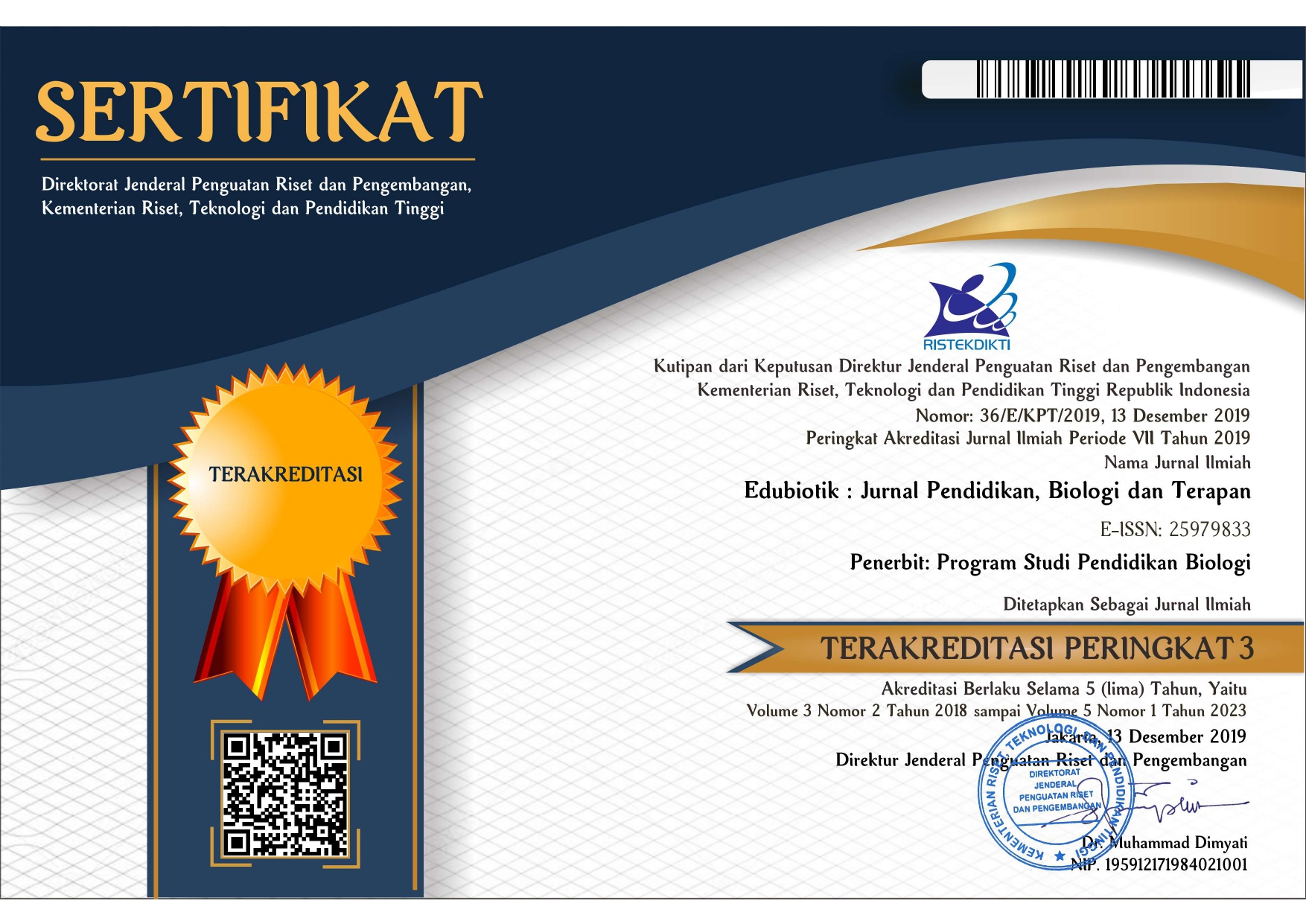Bay leaves (Syzygium polyanthum) extract as a repellent of Culex quinquefasciatus
Abstract
The study of bay leaf extract had been done to know its potential as Culex quinquefasciatus repellent. Bay leaf extract has the secondary metabolite compounds, such as terpenoid that is known as repellent of mosquitoes. The aim of this study was to determine the effect of bay leaf extract on Culex quinquefasciatus. The method used in this study was an experiment with complete randomized design which was consisted of six treatments and four repetitions. The treatment consisted of control (0%), P1 (10%), P2 (20%), P3 (30%), P4 (40%), and P5 (50%) of bay leaf extract. Data were analyzed by using one-way ANOVA. The results of this study showed the lowest mean of C. quinquefasciatus which repelled was 83% and the highest was 95,5%. Analysis of variance indicated that amount of C. quinquefasciatus which avoided bay leaf extract was significantly different. Based on the result, it can be concluded that bay leaf extract is potential as C. quinquefasciatus repellent.
References
Begashaw, B., Mishra, B., Tsegaw, A., & Shewamene, Z. (2017). Methanol leaves extract Hibiscus micranthus Linn exhibited antibacterial and wound healing activities. BMC Complementary and Alternative Medicine, 17(1), 1–11. https://doi.org/10.1186/s12906-017-1841-x
Campos, E. V. R., de Oliveira, J. L., Abrantes, D. C., Rogério, C. B., Bueno, C., Miranda, V. R., Monteiro, R. A., & Fraceto, L. F. (2020). Recent Developments in Nanotechnology for Detection and Control of Aedes aegypti-Borne Diseases. Frontiers in Bioengineering and Biotechnology, 8(February), 1–17. https://doi.org/10.3389/fbioe.2020.00102
Chen-Hussey, V., Behrens, R., & Logan, J. G. (2014). Assessment of methods used to determine the safety of the topical insect repellent N,N-diethyl-m-toluamide (DEET). Parasites and Vectors, 7(1). https://doi.org/10.1186/1756-3305-7-173
Cranston, G. &. (n.d.). Outline of Entomology. http://ibimm.org.br/wp-content/uploads/2017/05/The-Insects-An-Outline-of-Entomology.pdf
Dahmana, H., & Mediannikov, O. (2020). Mosquito-borne diseases emergence/resurgence and how to effectively control it biologically. Pathogens, 9(4), 1–26. https://doi.org/10.3390/pathogens9040310
De Santos, E. M. M., De Melo-Santos, M. A. V., De Oliveira, C. M. F., Correia, J. C., & De Albuquerque, C. M. R. (2012). Evaluation of a sticky trap (AedesTraP), made from disposable plastic bottles, as a monitoring tool for Aedes aegypti populations. Parasites and Vectors, 5(1), 2–11. https://doi.org/10.1186/1756-3305-5-195
Dudareva, N., Klempien, A., Muhlemann, J. K., & Kaplan, I. (2013). Biosynthesis, function and metabolic engineering of plant volatile organic compounds. New Phytologist, 198(1), 16–32. https://doi.org/10.1111/nph.12145
El-Zaeddi, H., Martínez-Tomé, J., Calín-Sánchez, Á., Burló, F., & Carbonell-Barrachina, Á. (2016). Volatile Composition of Essential Oils from Different Aromatic Herbs Grown in Mediterranean Regions of Spain. Foods, 5(4), 41. https://doi.org/10.3390/foods5020041
Fan, J., Francis, F., Liu, Y., Chen, J. L., & Cheng, D. F. (2011). An overview of odorant-binding protein functions in insect peripheral olfactory reception. Genetics and Molecular Research, 10(4), 3056–3069. https://doi.org/10.4238/2011.December.8.2
Fidan, H., Stefanova, G., Kostova, I., Stankov, S., Damyanova, S., Stoyanova, A., & Zheljazkov, V. D. (2019). Chemical Composition and Antimicrobial Activity of Laurus nobilis L. Essential oils from Bulgaria. Molecules, 24(4), 1–10. https://doi.org/10.3390/molecules24040804
Geck, M. S., Cristians, S., Berger-González, M., Casu, L., Heinrich, M., & Leonti, M. (2020). Traditional Herbal Medicine in Mesoamerica: Toward Its Evidence Base for Improving Universal Health Coverage. Frontiers in Pharmacology, 11(July). https://doi.org/10.3389/fphar.2020.01160
Geetha, R. V., & Roy, A. (2014). Essential oil repellents- A short review. International Journal of Drug Development and Research, 6(2), 20–27. https://www.itmedicalteam.pl/articles/essential-oil-repellents-a-short-review.pdf
Govindarajan, M. (2011). Larvicidal and repellent properties of some essential oils against Culex tritaeniorhynchus Giles and Anopheles subpictus Grassi (Diptera: Culicidae). Asian Pacific Journal of Tropical Medicine, 4(2), 106–111. https://doi.org/10.1016/S1995-7645(11)60047-3
Guo, S., Zhang, W., Liang, J., You, C., Geng, Z., Wang, C., & Du, S. (2016). Contact and Repellent Activities of the Essential Oil from Juniperus formosana against Two Stored Product Insects. Molecules, 21(4). https://doi.org/10.3390/molecules21040504
Guzmán, S. L., Reyes, R., & Bonilla, H. (2014). Medicinal plants for the treatment of “ nervios ”, anxiety , and depression in Mexican Traditional Medicine. Revista Brasileira de Farmacognosia, 24, 591–608. https://www.scielo.br/j/rbfar/a/p3kqjsDnN8fZxcdkgYbGQLC/?lang=en&format=pdf
Hill, S. R., Hansson, B. S., & Ignell, R. (2009). Characterization of antennal trichoid sensilla from female Southern house mosquito, culex quinquefasciatus say. Chemical Senses, 34(3), 231–252. https://doi.org/10.1093/chemse/bjn080
Jesus, A. S., Blank, A. F., Alves, M. F., Arrigoni-Blank, M. F., Lima, R. N., & Alves, P. B. (2016). Influence of storage time and temperature on the chemical composition of the essential oil of Hyptis pectinata L. Poit. Revista Brasileira de Plantas Medicinais, 18(1 suppl 1), 336–340. https://doi.org/10.1590/1983-084x/15_177
Jit Singh, K., & Kumar Thakur, A. (2014). Medicinal Plants of the Shimla hills, Himachal Pradesh: A Survey. ~ 118 ~ International Journal of Herbal Medicine, 2(2), 118–127. https://www.florajournal.com/archives/?year=2014&vol=2&issue=2&part=C&ArticleId=143
Kim, S. W., Lee, H. R., Jang, M. J., Jung, C. S., & Park, I. K. (2016). Fumigant toxicity of Lamiaceae plant essential oils and blends of their constituents against adult rice weevil Sitophilus oryzae. Molecules, 21(3), 1–10. https://doi.org/10.3390/molecules21030361
Kumar, S., Mishra, M., Wahab, N., & Warikoo, R. (2014). Larvicidal, Repellent, and Irritant Potential of the Seed-Derived Essential oil of Apium graveolens Against Dengue Vector, Aedes aegypti L. (Diptera: Culicidae). Frontiers in Public Health, 2(September), 1–6. https://doi.org/10.3389/fpubh.2014.00147
Manyi, M., Imandeh, G., & Azua, E. T. (2014). Vectorial Potential of Anopheles and Culex species in the Transmission of Bancroftian Filariasis in the Localities of Makurdi , North Central Nigeria . Journal of Entomology and Zoology Studies, 2(5), 171–177. https://www.entomoljournal.com/vol2Issue5/pdf/37.1.pdf
Medeiros, E. D. S., Rodrigues, I. B., Litaiff-Abreu, E., Pinto, A. C. D. S., & Tadei, W. P. (2013). Larvicidal activity of clove (Eugenia caryophyllata) extracts and eugenol against Aedes aegypti and Anopheles darlingi. African Journal of Biotechnology, 12(8), 836–840. https://doi.org/10.5897/ajb12.2678
Michele M., C., & O’Meara, G. F. (2008). Photographic guide to common mosquitoes of Florida. Florida Medical Entomology Laboratory. http://fmel.ifas.ufl.edu/key/
MSN, R., L, A., & S, S. (2016). Development of Herbal Mosquito Repellent Formulations. International Journal of Collaborative Research on Internal Medicine & Public Health, 8(6), 341–380. http://internalmedicine.imedpub.com/development-of-herbal-mosquito-repellent-formulations.php?aid=9474
Mudiana, D. (2016). Syzygium diversity in Gunung Baung, East Java, Indonesia. Biodiversitas, Journal of Biological Diversity, 17(2), 733–740. https://doi.org/10.13057/biodiv/d170248
Murugan, K, Pitchai, G. J., Madhiyazhagan, P., Nataraj, T., Nareshkumar, A., Hwang, J.-S., Chandrasekar, R., Nicoletti, M., Amsath, A., & Bhagooli, R. (2014). Larvicidal, Repellent and Smoke Toxicity Effect of Neem Products Against Malarialvector, Anopheles Stephensi. International Journal of Pure and Applied Zoology ISSN (Print ISSN, 2(2), 2320–9577. http://www.ijpaz.com
Murugan, Kadarkarai, Benelli, G., Ayyappan, S., Dinesh, D., Panneerselvam, C., Nicoletti, M., Hwang, J. S., Kumar, P. M., Subramaniam, J., & Suresh, U. (2015). Toxicity of seaweed-synthesized silver nanoparticles against the filariasis vector Culex quinquefasciatus and its impact on predation efficiency of the cyclopoid crustacean Mesocyclops longisetus. Parasitology Research, 114(6), 2243–2253. https://doi.org/10.1007/s00436-015-4417-z
Nerio, L. S., Olivero-Verbel, J., & Stashenko, E. (2010). Repellent activity of essential oils: A review. Bioresource Technology, 101(1), 372–378. https://doi.org/10.1016/j.biortech.2009.07.048
Online, F. A., State, J., & Chemistry, I. (2020). JOURNAL OF BIOTECHNOLOGY AND BIOMEDICAL SCIENCE Bioactive Chemical Compounds ( Phytochemicals ). 1. https://doi.org/10.14302/issn.2576
Paluch, G., Grodnitzky, J., Bartholomay, L., & Coats, J. (2009). Quantitative structure-activity relationship of botanical sesquiterpenes: Spatial and contact repellency to the yellow fever mosquito, aedes aegypti. Journal of Agricultural and Food Chemistry, 57(16), 7618–7625. https://doi.org/10.1021/jf900964e
Pushpanathan, T., Jebanesan, A., & Govindarajan, M. (2008). The essential oil of Zingiber officinalis Linn (Zingiberaceae) as a mosquito larvicidal and repellent agent against the filarial vector Culex quinquefasciatus Say (Diptera: Culicidae). Parasitology Research, 102(6), 1289–1291. https://doi.org/10.1007/s00436-008-0907-6
Putri, L. S. E. (2016). Ethnobotanical study of herbal medicine in Ranggawulung Urban Forest, Subang District, West Java, Indonesia. Biodiversitas, Journal of Biological Diversity, 17(1), 172–176. https://doi.org/10.13057/biodiv/d170125
Sinurat, J. P., Krisdianilo, V., Karo, R. M. br, & Berutu, R. (2020). Analysis of Total Terpenoids from Maniltoa Grandiflora (A. Gray) Scheff Leaves Using TLC and HPLC Methods. Stannum : Jurnal Sains Dan Terapan Kimia, 2(2), 5–9. https://doi.org/10.33019/jstk.v2i2.1976
Syed, Z., & Leal, W. S. (2008). Mosquitoes smell and avoid the insect repellent DEET. Proceedings of the National Academy of Sciences, 105(36), 13598–13603. https://doi.org/10.1073/pnas.0805312105
Tawatsin, A., Asavadachanukorn, P., Thavara, U., Wongsinkongman, P., Bansidhi, J., Boonruad, T., Chavalittumrong, P., Soonthornchareonnon, N., Komalamisra, N., & Mulla, M. S. (2006). Repellency of essential oils extracted from plants in Thailand against four mosquito vectors (Diptera: Culicidae) and oviposition deterrent effects against Aedes aegypti (Diptera: Culicidae). Southeast Asian Journal of Tropical Medicine and Public Health, 37(5), 915–931. https://pubmed.ncbi.nlm.nih.gov/17333734/
Wanzala, W., & Ogoma, S. B. (2013). Chemical Composition and Mosquito Repellency of Essential Oil of Tagetes minuta from the Southern Slopes of Mount Elgon in Western Kenya. Journal of Essential Oil-Bearing Plants, 16(2), 216–232. https://doi.org/10.1080/0972060X.2013.793975
Wooding, M., Naudé, Y., Rohwer, E., & Bouwer, M. (2020). Controlling mosquitoes with semiochemicals: A review. Parasites and Vectors, 13(1), 1–20. https://doi.org/10.1186/s13071-020-3960-3
Wu, Y., Zhang, W. J., Wang, P. J., Yang, K., Huang, D. Y., Wei, J. Y., Tian, Z. F., Bai, J. F., & Du, S. S. (2015). Contact toxicity and repellency of the essential oil of Liriope muscari (Decn.) bailey against three insect tobacco storage pests. Molecules, 20(1), 1676–1685. https://doi.org/10.3390/molecules20011676
Yang, Y.-C., Lee, E.-H., Lee, H.-S., Lee, D.-K., & Ahn, Y.-J. (2004). Repellency of aromatic medicinal plant extracts and a steam distillate to Aedes aegypti. Journal of the American Mosquito Control Association, 20(2), 146–149. http://www.ncbi.nlm.nih.gov/pubmed/15264623
Zhu, J. J., Cermak, S. C., Kenar, J. A., Brewer, G., Haynes, K. F., Boxler, D., Baker, P. D., Wang, D., Wang, C., Li, A. Y., Xue, R. de, Shen, Y., Wang, F., Agramonte, N. M., Bernier, U. R., de Oliveira Filho, J. G., Borges, L. M. F., Friesen, K., & Taylor, D. B. (2018). Better than DEET Repellent Compounds Derived from Coconut Oil. Scientific Reports, 8(1), 1–12. https://doi.org/10.1038/s41598-018-32373-7
Zulcafli, A. S., Lim, C., Ling, A. P., Chye, S., & Koh, R. (2020). Antidiabetic potential of syzygium sp.: An overview. Yale Journal of Biology and Medicine, 93(2), 307–325. https://pubmed.ncbi.nlm.nih.gov/32607091/
Zwiebel, L. J., & Takken, W. (2004). Olfactory regulation of mosquito-host interactions. Insect Biochemistry and Molecular Biology, 34(7), 645–652. https://doi.org/10.1016/j.ibmb.2004.03.017





.png)
2.png)

1.jpg)


